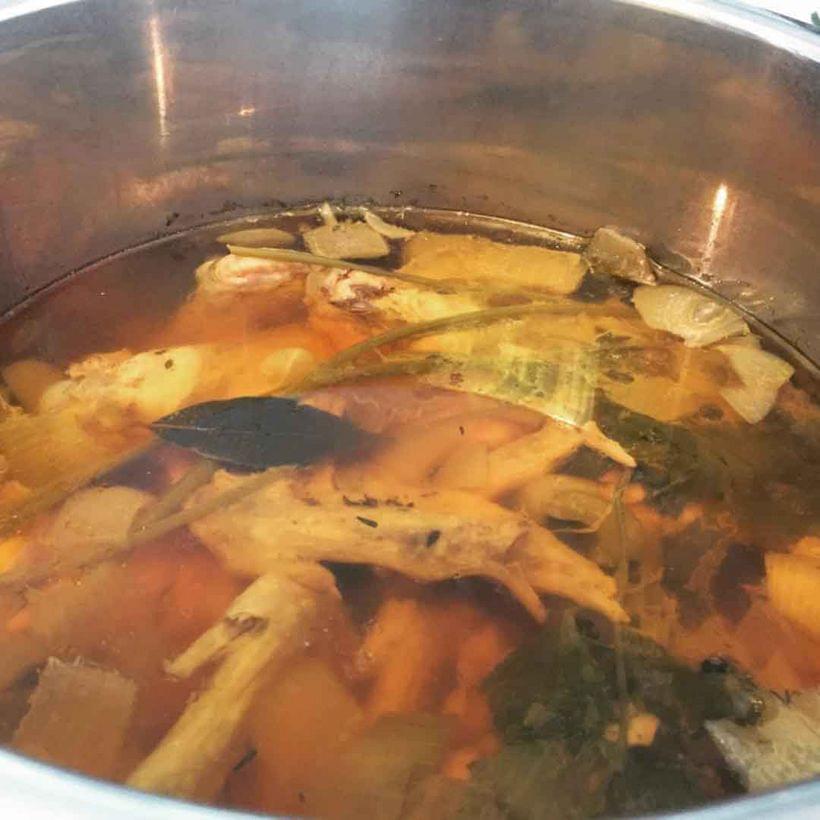Utility Stock

I’ve spent a lot of time trying to turn freezer section ingredients into ramen-caliber stock, and this is the result.
If I were the sort of person who comes to possess chicken backs during the course of my day-to-day life, well, this would be a different recipe. Leave out the shortribs and you’ve got my go-to chicken stock; leave them in and you’ve got something rich enough enough to hold up to Curry Rice, form the basis for ramen, or just, y’know, be a soup.
I’d maybe call this “toridashi,” but not confidently. I know “tori” means chicken and I know “dashi” means stock—but this is more of a pork stock than anything else. The BBC has a recipe for something kind of similar, and they call it “toridashi,” so hey, why not. It’s really more of a broth, where I’m starting with off-the-shelf proteins and not a Halloween’s worth of bones.
There are only a couple of things in here that you might have trouble finding at your local supermarket: kombu and katsuobushi. They’re the basis for glutimate-rich dashi: a salty kelp and dried, smoked, fermented skipjack tuna flakes. Those might require a trip to a store that specializes in Japanese ingredients—or, y’know, Amazon. You can get by without them here, but they’re cheap and shelf-stable; they’re good to have in.
On Clarity
Thanks to years of cooking The French Way, I’ve always sought to make crystal-clear stocks—avoiding any boil beyond the initial bone-scrubbing boil. I still get plenty of milage out of a white stock—in fact, I more or less use this same recipe for it, give or take a couple sprigs of thyme, minus the pork, without browning steps, and with one important difference: the speed at which I depressurize my pressure cooker.
See, boiling is the enemy of clear stocks. All that activity emulsifies the fats, and those emulsified fats make things cloudy. This isn’t a bad thing: when you’re aiming for a super rich stocks—think tonkotsu—but it probably isn’t what you’d want in a delicately-balanced risotto. On a stovetop, that involves some fussing; you want to keep the temperature high enough to, y’know, make stock, but without letting it tip over into a boil.
As hot as it gets in there, a pressure cooker likely won’t bring your stock to a full rolling boil; the pressure actually prevents it. If you hit the manual release, though, things come to a boil in a hurry—giving you a cloudy, fatty stock, for better or worse.
So, Yeah: Instant Pot
Let’s get this out of the way early on in the life of this blog: the Instant Pot is extremely good. I mean, it’s not all good—the interface is largely inscrutable, and the “sauté” function tends to err a little on the side of “char”—but for my money, it beats the hell out of messing around with a stovetop pressure cooker. I’ll do a full review of it at some point.
Now, because I’ve got deep-seated temperature control issues, I tend to avoid the built-in “sauté” setting for the browning and initial boiling steps. I don’t know that I’m supposed to, warranty-wise, but I pull the inner pot and set it right on the burner instead of dirtying a stockpot. If you want to one-pot this thing, though, I won’t stop you: just sauté the aeromatics in there instead of a stand-alone skillet, and set them aside until you’re ready for them.
You can get by without a pressure cooker, for sure—because this thing errs on the side of over-the-top richness, it won’t mean eight hours of carefully attended simmering. But, since you’re not dealing exclusively with bones, extracting enough gelatin to make it feel rich might require a little help—add a packet of gelatin early on, and you’re good to go.
On Salt
Notice that I don’t add salt anywhere in here—same reason I burn through so much unsalted butter, and use little-to-no-salt-added store-bought stock in a pinch: you’re gonna be able to add more salt to whatever you end up making with this. You’re not gonna be able to take salt out.
Ingredients
-
11/2 lb. Chicken Wings
-
1/2 rack Shortribs
-
2 Onions, one halved, one roughly chopped
-
15 G. Ginger, roughly chopped
-
2 Leeks, whites and light green parts only, chopped
-
3 Carrots, roughly chopped
-
3 Celery Stalks, roughly chopped
-
A few Sprigs of Parsley
-
~10 Peppercorns, whole
-
1 Bay Leaf
-
4"x4" square Kombu, lightly rinsed and patted dry
-
20 G Katsuobushi
Instructions
Heat vegetable oil in a cast iron (or non-stick skillet) over high heat, until lightly smoking. Working in batches, brown both sides of the chicken wings and shortribs.
Place the chicken wings and ribs in a stockpot and cover with cold water. Bring to a boil over high heat. Meanwhile, add chopped onions, leeks, carrots, celery, and onion halves (cut sides down) to the skillet. Cook, tossing occasionally, until onions are slightly browned—about 10–15 minutes. Set aside.
Once water has come to a boil, pour it out. Rinse the chicken wings and shortribs thoroughly, then return them to the pot, along with browned aeromatics, herbs, peppercorns, katsuobushi, and kombu. Bring to a bare simmer over medium heat, skimming occasionally.
When bubbles just start to form (or the temperature reaches 190 degrees F on an instant-read thermometer), remove the kombu.
If you’re using a pressure cooker, seal and cook at high pressure for about an hour. On a stovetop, add gelatin and maintain at a bare simmer for several hours. Afterwards, either release pressure manually, or allow it to cool to room temperature under pressure, depending on the desired clarity. Remove solids using a mesh strainer and cheesecloth.